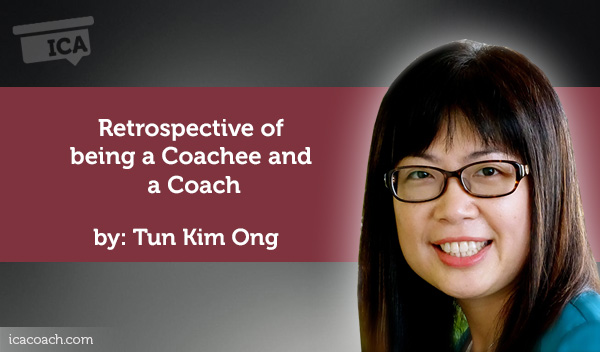
Coaching Case Study By Tun Kim Ong
(Career Coach, SINGAPORE)
Coaching is not a series of isolated activities; it is a relationship. It is not a discrete conversation; it is an ongoing dialogue.
My Reflection as a Coachee
My coach set a good example for me to model as she demonstrated these competencies during the coaching sessions. Our first coaching session was to establish common understanding of the expectations of the coaching relationship and to get to know each other.
In each of the coaching session, the focus was on me. My coach made me feel comfortable and relaxed. I felt that I am the STAR because she was present with me, held my agenda and willing to go with my direction and flow.
I observed that my coach “checked in” with me at the start of every coaching session on my emotions and how I felt that day. I liked the approach as it helped to build the relationship and created a supportive coaching climate. Throughout the session, she asked open ended questions which provided me opportunities to elaborate and verbalise my thoughts, ideas. She used “What” and “How” and not “Why”. She also gave me time to think and respond. Powerful questions helped to lead me think differently and more deeply.
At the end of the session, we “checked out” on what were the take away and what actions that I will take. I learnt that it is important for the coach to help coachee achieve what they desire by creating actions. Hence, creating actions is setting up a good solid structure for moving coachee forward.
One of the best ways to move coachee into action is to focus on their strengths and acknowledge them. When the focus is on the strength, confidence will grow and chances to move forward will increase. Acknowledgement is a way of encouragement and this gives coachee the momentum to continue the journey. My coach said “Yeah! You have completed what you wanted to do this week. You did well and on the right track to accomplish your goal.” I was encouraged to continue in my journey.
Lastly, although, our coaching sessions were done via video conference, it did not affect the effectiveness and quality of the sessions. We could see each other’s body language. Of course, it would be more ideal for coaching to be done face to face as you can feel the energy when in the same room.
My Reflection as a Coach
My coachee is an energetic young man who has worked for 2 years after graduation and in his early career growth. He is at the stage where he makes decisions on many commitments. He is planning to get married, further his studies in Masters, take on more responsibilities at work and excel in them, learn new skills to stay relevant as well as continue to contribute to the community service. There are many things that he would like to accomplish.
The coaching session went on smoothly because he was very open in his communications. He felt it was a safe and supportive environment. I was encouraged that the coachee felt this way.
We spoke about his values and his strengths. While my coachee knew his strength from friends and family feedback, he was keen to use the StrengthFindertool. This tool can help him to discover more of his internal strengths; focus on his dominant talent themes and to use them every day. The self-awareness of the strengths can help to motivate and encourage him.
With many things to be accomplished, we used the Wheel of Life to graphically visualize each of the important areas of his life, where his current balance and ideal balance was and identified the top 2-3 commitments to be prioritized. He was determined to give more time to these commitments and used mind map to draw out his actions.
During each coaching session, I put in lots of efforts to practice active listening. I listened not just what my coachee is saying but how he is saying it. I also applied the equation to listen 80% of the time and speak 20% of the time. Active listening is not easy but vital in my coaching. I reminded myself with this acronym: W.A.I.T – Why or What Am I Talking?
One challenge that I faced was my tendency to come up with suggestions and solutions for the coachee because of prior experience and career in people management. Hence, my strategy is to hold back my suggestions by counting to five. With the space given, the coachee can usually come up with own actions and solutions.
Overall, my coaching experience was enriching and I felt a sense of achievement.
Conclusion
Coaches help people improve their performances and enhance the quality of their personal and professional lives. Coaching focuses on where the people are right now, where they want to be next and how to get them there.
To be a role model to my coachees, I will pursue my own balanced and fulfilling life by investing in myself. Firstly, to have a coach who will help me learn and make progress towards my goals. Secondly, to adopt these mindsets in all interactions.
I believe I can add value to my coachee, inspire and maximize their personal and professional potential. My gratitude to my coaches and coachee for giving me the opportunity to be coached and to coach.